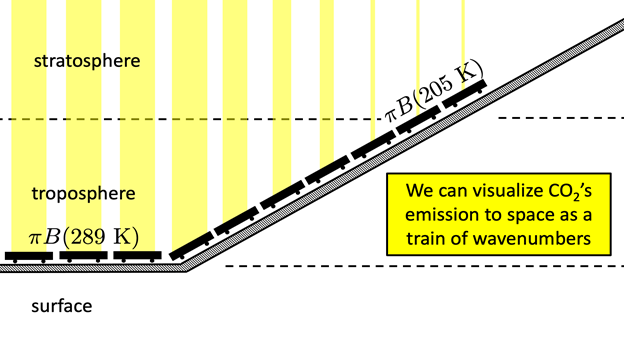Why we get the same forcing for each doubling of CO2
Submitter
Romps, David — Lawrence Berkeley National Laboratory
Area of Research
Radiation Processes
Journal Reference
Romps D, J Seeley, and J Edman. 2022. "Why the forcing from carbon dioxide scales as the logarithm of its concentration." Journal of Climate, 35(1 3), 10.1175/JCLI-D-21-0275.1.
Science

Figure 1. The emission to space in an atmosphere that is dominated radiatively by carbon dioxide may be visualized as equal-sized batches (train cars) of emission to space uniformly distributed from the surface up to the stratosphere. Each doubling of carbon-dioxide concentration moves the train forward one car length, effectively replacing a train car at the surface with a train car in the stratosphere. Image courtesy of David M. Romps.
It is well known that the radiative forcing (i.e., effected decrease in outgoing longwave radiation) from carbon dioxide is approximately logarithmic in its concentration, producing about four watts per square meter of global-mean forcing for each doubling. These are basic facts of climate science that serve as a foundation of our understanding of anthropogenic global warming, yet competing explanations for these basic facts have been given in the literature in recent years. Here, the various pieces of physics that conspire to generate the logarithmic forcing are explored in detail using both line-by-line radiative-transfer calculations and a simple pencil-and-paper model for the forcing. An essential part of the mechanism is the particular distribution of absorption coefficients within the 15-micron band of carbon dioxide.
Impact
An alternative explanation has been given repeatedly in the literature relying on the particular lapse rate of Earth's troposphere, and that explanation would appear to work for any greenhouse gas. It is shown here that that alternate explanation is incorrect: it is neither necessary nor sufficient to explain the logarithmic forcing of carbon dioxide and it is generally inapplicable to well-mixed greenhouse gases in Earth’s atmosphere.
Summary
The basic mechanism by which increases in CO2 lead to additional radiative forcing is robust. Not only can this forcing be understood with a simple quantitative model, but the model makes clear why the forcing is logarithmic (i.e., why each doubling of concentration gives the same additional forcing) and why its magnitude is around four watts per square meter. This work helps to lay to rest an alternate explanation that has appeared in papers and textbooks.
Keep up with the Atmospheric Observer
Updates on ARM news, events, and opportunities delivered to your inbox
ARM User Profile
ARM welcomes users from all institutions and nations. A free ARM user account is needed to access ARM data.


















